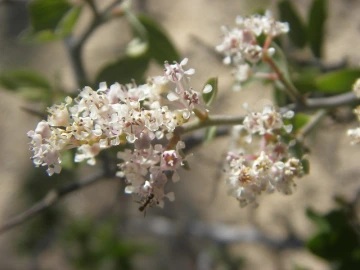
Anthony Mendoza Flickr.com
Botanical Family: Rhamnaceae
Scientific Name: Ceanothus fendleri
Common Names: Fendler's ceanothus, Fendler ceanothus
Botanical Description:
Ceanothus fendleri is a perennial shrub that grows up to three feet tall, with a low, spreading habit. The branches are greenish-brown, glaucous, and fuzzy, terminating in two-inch thorns. The terminal thorn differentiates the species from C. greggii, which lacks thorns (1, 2, 3). The leaves have three prominent veins, and are dark gray and hairless on the upper surface, and pubescent and paler in color on the lower surface (1, 2). White flowers, produced from spring to fall, grow in dense, rounded panicle-like clusters. Individual flower blooms have five spoon-shaped petals, five triangular sepals, and five stamens (2, 3). Successfully pollinated flowers will produce a plump, triangular-shaped, red fruit that dries into a brown capsule (2, 3).
Ecological Significance:
The Fendler’s ceanothus is a host to caterpillars of the Nais metalmark (Apodemia nais), Pacuvius duskywing (Erynnis pacuvius), and Cecrops eyed silkmoth (Automeris cecrops), and is pollinated by bees (4, 5). Livestock and deer browse the species, leading to the common names “buck-brush” and “deer-brier” (3). Additionally, the root system of C. fendleri not only prevents soil erosion, but also forms symbiotic relationships with nitrogen-fixing soil microbes, making it ideally suited for soil restoration projects (5).
Ethnobotanical Value:
The Indigenous people of the American Southwest have valued Fendler’s ceanothus for cultural, medicinal, and culinary uses. Historically, the Acoma Pueblo and Laguna Pueblo sweetened and consumed the berries (3). The Keres Pueblo chewed the leaves to treat a sore mouth, while the Navajo used the species in a poultice as a natural sedative to treat nervousness (3, 5). The Navajo also valued C. fendleri in cultural rituals, using both the leaves and stem for numerous ceremonies (3).

